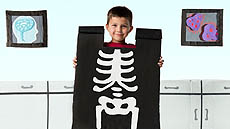Detectors in daily life
 |
| Not only are particle detectors essential to making discoveries in particle physics, they also play important roles in industry, science and medicine. Photo: Reidar Hahn |
Ask someone what our world would look like if there were no cars or no telephones and they'll probably have an immediate answer. It's easy to imagine how our lives would be different without these things. But what if there were no particle detectors? Most people aren't sure what would change if these devices disappeared — even though particle detectors are at work all around us.
Particle detectors play a role in undertakings from drug development to medical imaging, from protecting astronauts to dating ancient artifacts, from testing materials to understanding the universe.
A particle detector is a device built to observe and identify particles. Some measure photons, particles of light such as the visible light from stars or the invisible X-rays we use to examine broken bones. Other particle detectors identify protons, neutrons and electrons — the particles that make up atoms — or even entire atoms. Some detectors are designed to detect antimatter. By sensing the electric charge and interactions of particles, the detectors can determine their presence, their energy and their motion.
It may seem like an esoteric task, but particle detection is a part of our everyday lives.
A chance of rain
Without particle detectors, climate models and weather forecasts would be a bit cloudy.
One of the most common tools used in modern weather forecasting is radar — radio waves sent through the air, bounced off of objects (such as rain drops) and collected by radio-frequency (RF) detectors. Using radar, scientists can gather information about the location, size and distribution of raindrops or other precipitation, as well as wind speed and direction and other variables. Some more advanced instruments apply the same technique using microwaves or lasers instead of radio waves. Radar is also a primary tool in the study of tornadoes and other severe storms, often with the goal of improving safety measures for people on the ground.
The Earth's climate — the long-term behavior of the atmosphere — is largely created by the interplay between two fluids: water and air. Fluids can be studied in detail in the laboratory using experimental devices that carefully track their complex motions using X-rays and other techniques that rely on particle detectors. Work done in the lab feeds into a growing understanding of our planet's complex climate.
At CERN European research center, the Cosmics Leaving Outdoor Droplets experiment, or CLOUD, is investigating the link between energetic particles from space, known as cosmic rays, and the formation of clouds in our atmosphere. The experiment suggests that the rays create aerosols, which act as seeds for new clouds. CLOUD scientists try to recreate atmospheric conditions inside a sealed chamber and use detectors to carefully monitor changes taking place. CLOUD's findings should help scientists better understand the effects of clouds and aerosols on Earth's climate.
Read more
—Calla Cofield
|